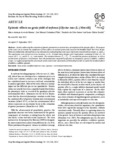Please use this identifier to cite or link to this item:
http://www.alice.cnptia.embrapa.br/alice/handle/doc/945909| Title: | Epistatic effects on grain yield of soybean [Glycine max (L.) Merrill]. |
| Authors: | BARONA, M. A. A.  COLOMBARI FILHO, J. M.   SANTOS, V. da S.   GERALDI, I. O.   |
| Affiliation: | MARCO ANTONIO ACEVEDO BARONA, INIA; JOSE MANOEL COLOMBARI FILHO, CNPAF; VANDERLEI DA SILVA SANTOS, CNPMF; ISAIAS OLÍVIO GERALDI, ESALQ. |
| Date Issued: | 2012 |
| Citation: | Crop Breeding and Applied Biotechnology, v. 12, n. 4, p. 231-236, 2012. |
| Description: | Studies addressing the estimation of genetic parameters in soybean have not emphasized the epistatic effects. The purpose of this study was to estimate the significance of these effects on soybean grain yield, based on the Modified Triple Test Cross design. Thirty-two inbred lines derived from a cross between two contrasting lines were used, which were crossed with two testers (L1 and L2). The experiments were carried out at two locations, in 10 x 10 triple lattice designs with 9 replications, containing 32 lines (Pi ), 64 crosses (32 Pi x L1 and 32 Pi x L2 ) and controls. The variation between ( L li + L 2i - P i ) revealed the presence of epistasis, as well as an interaction of epistasis x environment. Since the predominant component of epistasis in autogamous species is additive x additive (i type), we suggest postponing the selection for grain yield to later generations of inbreeding in order to exploit the beneficial effects of additive x additive epistasis. |
| Thesagro: | Soja Gene Interação genética |
| NAL Thesaurus: | Epistasis Gene expression regulation Genotype-environment interaction |
| Keywords: | Regulação da expressão genética Soybean |
| Type of Material: | Artigo de periódico |
| Access: | openAccess |
| Appears in Collections: | Artigo em periódico indexado (CNPAF)  |










